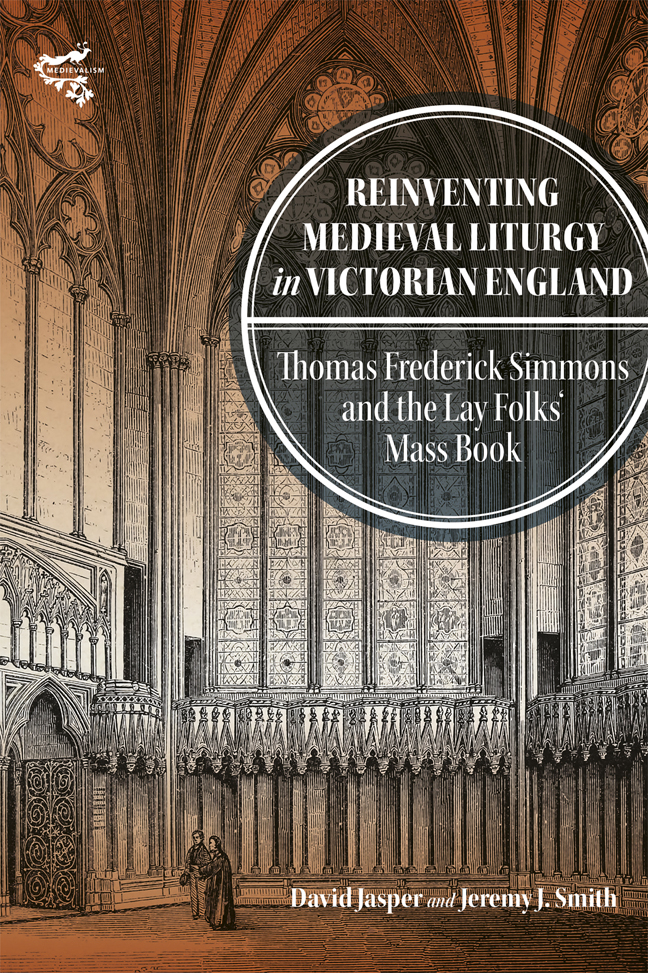 Reinventing Medieval Liturgy in Victorian England
Reinventing Medieval Liturgy in Victorian England Book contents
- Frontmatter
- Dedication
- Contents
- List of Plates
- Preface
- A note on citations
- List of abbreviations
- Introduction: Imagining the Past
- 1 Thomas Frederick Simmons and The Lay Folks’ Mass Book
- 2 Re-imagining Medieval Devotion: Nineteenth-Century Conceptions of the English Church
- 3 Simmons and the Early English Text Society
- 4 Simmons as Editor: The Philologist
- 5 Simmons as Editor: The Liturgist
- 6 Simmons as Parish Priest, and Liturgical Reform in the Victorian Church of England
- 7 The Afterlives of The Lay Folks’ Mass Book
- Conclusion: Liturgical Moments in Time
- Plates
- Appendix I The Lay Folks’ Mass Book: Text and Translation
- Appendix II The Lay Folks’ Mass Book and the Sarum Rite
- Bibliography
- Index
- Miscellaneous Endmatter
Conclusion: Liturgical Moments in Time
Published online by Cambridge University Press: 02 March 2024
- Frontmatter
- Dedication
- Contents
- List of Plates
- Preface
- A note on citations
- List of abbreviations
- Introduction: Imagining the Past
- 1 Thomas Frederick Simmons and The Lay Folks’ Mass Book
- 2 Re-imagining Medieval Devotion: Nineteenth-Century Conceptions of the English Church
- 3 Simmons and the Early English Text Society
- 4 Simmons as Editor: The Philologist
- 5 Simmons as Editor: The Liturgist
- 6 Simmons as Parish Priest, and Liturgical Reform in the Victorian Church of England
- 7 The Afterlives of The Lay Folks’ Mass Book
- Conclusion: Liturgical Moments in Time
- Plates
- Appendix I The Lay Folks’ Mass Book: Text and Translation
- Appendix II The Lay Folks’ Mass Book and the Sarum Rite
- Bibliography
- Index
- Miscellaneous Endmatter
Summary
As We Have seen, the later years of the nineteenth century saw numerous popular publications by Church of England clergymen of works intended to provide commentary and assistance to both laity and priests in their participation in the liturgy of Holy Communion. Non-Eucharistic services and offices were catered for by books like The Priest’s Prayer Book, with a brief pontifical (London, 1864) by R. F. Littledale and J. E. Vaux, both ritualist clergymen, which was repeatedly reprinted into the twentieth century following considerable enlargement in 1870. This was designed as ‘an Appendix to the Book of Common Prayer’, intended as a pastoral aid for parish clergy. To assist the laity and ‘intended chiefly for such as do not communicate oftener than once a month’ there was – as we have seen – W. E. Scudamore’s Steps to the Altar: A Manual of Devotions for the Blessed Eucharist (London, 1866). Echoes of the LFMB are clear in this often-reprinted manual in which Scudamore, on at least one occasion (as we have seen) the victim of Simmons’ scholarly correction, offers, very much in the spirit of the LFMB, ‘a few directions for the behaviour of the communicant to accompany the devotions provided for use during the celebration’. And we have already referred on several occasions to Medd’s widely-used The Priest to the Altar, drawing largely on ‘the ancient English Use of Sarum’, of which the revised and enlarged third edition was published in the same year as Simmons’ LFMB, viz. 1879.
But perhaps the most significant and enduring of works in the tradition of the LFMB was a product of the eighteenth century, though regularly reprinted for over a century afterwards: Bishop Thomas Wilson’s A Short Instruction for the True Understanding of the Lord’s Supper (London, 1734).
Thomas Wilson (1663–1755), Bishop of Sodor and Man from 1697 to 1755, was a notable churchman who was known and loved for his scholarship, his piety and his pastoral energy. Among many other good works Wilson built libraries for the education of his people on the Isle of Man. His Sacra privata – a collection of per-sonal prayers – were widely read until the early twentieth century, running through twenty-four publications (ten of them in the USA) between 1796 and 1903, includ-ing an Oxford edition with an introduction by a young John Henry Newman.
- Type
- Chapter
- Information
- Reinventing Medieval Liturgy in Victorian EnglandThomas Frederick Simmons and The 'Lay Folks' Mass Book', pp. 165 - 168Publisher: Boydell & BrewerPrint publication year: 2023


